Related Research Articles

Food preservation includes food processing practices which prevent the growth of microorganisms, such as yeasts, and slow the oxidation of fats that cause rancidity. Food preservation may also include processes that inhibit visual deterioration, such as the enzymatic browning reaction in apples after they are cut during food preparation. By preserving food, food waste can be reduced, which is an important way to decrease production costs and increase the efficiency of food systems, improve food security and nutrition and contribute towards environmental sustainability. For instance, it can reduce the environmental impact of food production.
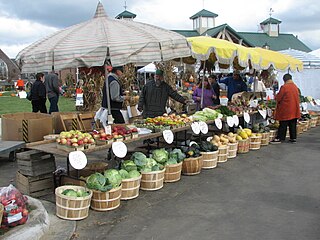
A farmers' market is a physical retail marketplace intended to sell foods directly by farmers to consumers. Farmers' markets may be indoors or outdoors and typically consist of booths, tables or stands where farmers sell their produce, live animals and plants, and sometimes prepared foods and beverages. Farmers' markets exist in many countries worldwide and reflect the local culture and economy. The size of the market may be just a few stalls or it may be as large as several city blocks. Due to their nature, they tend to be less rigidly regulated than retail produce shops.

A frozen meal is a packaged frozen meal that comes portioned for an individual. A frozen meal in the United States and Canada usually consists of a type of meat for the main course, and sometimes vegetables, potatoes, and/or a dessert. The main dish can also be pasta or fish. In European frozen meals, Indian and Chinese meals are common. Another form of convenience food, which is merely a refrigerated ready meal that requires less heating but expires sooner, is popular in the UK.

Food processing is the transformation of agricultural products into food, or of one form of food into other forms. Food processing includes many forms of processing foods, from grinding grain to make raw flour to home cooking to complex industrial methods used to make convenience foods. Some food processing methods play important roles in reducing food waste and improving food preservation, thus reducing the total environmental impact of agriculture and improving food security.
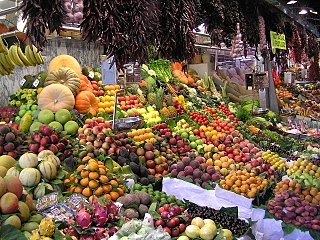
Produce is a generalized term for many farm-produced crops, including fruits and vegetables. More specifically, the term produce often implies that the products are fresh and generally in the same state as where and when they were harvested.

A market garden is the relatively small-scale production of fruits, vegetables and flowers as cash crops, frequently sold directly to consumers and restaurants. The diversity of crops grown on a small area of land, typically from under 0.40 hectares to some hectares, or sometimes in greenhouses, distinguishes it from other types of farming. A market garden is sometimes called a truck farm.

Modified atmosphere packaging (MAP) is the practice of modifying the composition of the internal atmosphere of a package in order to improve the shelf life. The need for this technology for food arises from the short shelf life of food products such as meat, fish, poultry, and dairy in the presence of oxygen. In food, oxygen is readily available for lipid oxidation reactions. Oxygen also helps maintain high respiration rates of fresh produce, which contribute to shortened shelf life. From a microbiological aspect, oxygen encourages the growth of aerobic spoilage microorganisms. Therefore, the reduction of oxygen and its replacement with other gases can reduce or delay oxidation reactions and microbiological spoilage. Oxygen scavengers may also be used to reduce browning due to lipid oxidation by halting the auto-oxidative chemical process. Besides, MAP changes the gaseous atmosphere by incorporating different compositions of gases.
Hydrolyzed vegetable protein (HVP) products are foodstuffs obtained by protein hydrolysis and are used as ingredients to create a bouillon (broth) taste without the vegetables, bones, simmering, or other standard elements of creating bouillon from scratch.
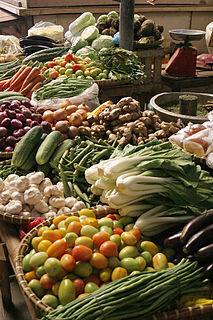
Vegetables are parts of plants that are consumed by humans or other animals as food. The original meaning is still commonly used and is applied to plants collectively to refer to all edible plant matter, including the flowers, fruits, stems, leaves, roots, and seeds. An alternative definition of the term is applied somewhat arbitrarily, often by culinary and cultural tradition. It may exclude foods derived from some plants that are fruits, flowers, nuts, and cereal grains, but include savoury fruits such as tomatoes and courgettes, flowers such as broccoli, and seeds such as pulses.
HVP may refer to:

A fruit stand is a primarily open-air business venue that sells seasonal fruit and many fruit products from local growers. It might also sell vegetables and various processed items derived from fruit. The fruit stand is a small business structure that is primarily run as an independent sole proprietorship, with very few franchises or branches of larger fruit stand conglomerates, though many large food industry businesses have developed from fruit stand businesses.

The term fish processing refers to the processes associated with fish and fish products between the time fish are caught or harvested, and the time the final product is delivered to the customer. Although the term refers specifically to fish, in practice it is extended to cover any aquatic organisms harvested for commercial purposes, whether caught in wild fisheries or harvested from aquaculture or fish farming.
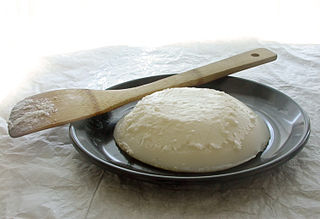
Lard is a semi-solid white fat product obtained by rendering the fatty tissue of a pig. It is distinguished from tallow, a similar product derived from fat of cattle or sheep.

Laiki agora, also common in the plural Laikes agores, are farmers' markets that operate all over Greece, selling foodstuffs and gardening or household equipment, as well as children's toys and various "do it yourself" tools.
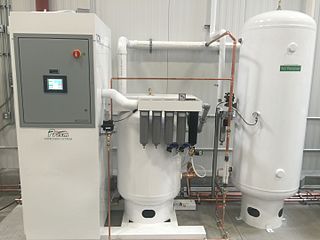
Modified atmosphere/modified humidity (MA/MH) packaging is a technology used to preserve the quality of fresh produce so that it can be sold to markets far away from where it is grown, extend the marketing period, and to help suppliers reduce food waste within the cold chain. Commercial examples of MA/MH include sea freight of Galia and cantaloupe melons from Central and South America to Europe and North America ; transport of white asparagus from fields in Peru to markets in Western Europe ; and trucking of cherries from orchards in Turkey to supermarkets in the UK.
The term intermediate agricultural products generally refers to agricultural products that have a higher per-unit value than bulk commodities. They are often partly processed but not necessarily ready for the consumers. Examples might include soybean meal, wheat flour, vegetable oils, feeds and fodders, animal fats, hides and skins, live animals, and sweeteners such as sugars. Applied to trade policy, intermediate products are one of three categories of agricultural products used by the Foreign Agricultural Service to report export and import data under its BICO system.
Produce traceability makes it possible to track produce from its point of origin to a retail location where it is purchased by consumers.
In the agricultural context, diversification can be regarded as the re-allocation of some of a farm's productive resources, such as land, capital, farm equipment and labour to other products and, particularly in richer countries, to non-farming activities such as restaurants and shops. Factors leading to decisions to diversify are many, but include: reducing risk, responding to changing consumer demands or changing government policy, responding to external shocks and, more recently, as a consequence of climate change.
Basic Food Flavors, Inc. is a private company based in North Las Vegas, Nevada, United States. Established in 1980, they have developed a line of hydrolyzed vegetable protein (HVP), soy sauce and soy base products. It produces 120 varieties of HVP which are used in various products including chips, soups, dressings and snack foods. A private company which does not make financial information public, its annual sales have been estimated as between $20 and $50 million.
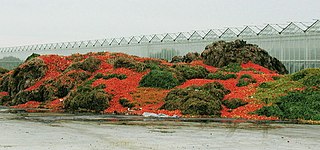
Post-harvest losses of vegetables and fruit occur at all points in the value chain from production in the field to the food being placed on a plate for consumption. Post-harvest activities include harvesting, handling, storage, processing, packaging, transportation and marketing.
References
![]() This article incorporates public domain material from Jasper Womach. Report for Congress: Agriculture: A Glossary of Terms, Programs, and Laws, 2005 Edition (PDF). Congressional Research Service.
This article incorporates public domain material from Jasper Womach. Report for Congress: Agriculture: A Glossary of Terms, Programs, and Laws, 2005 Edition (PDF). Congressional Research Service.